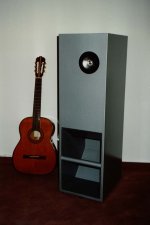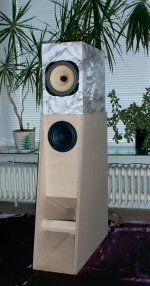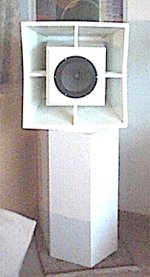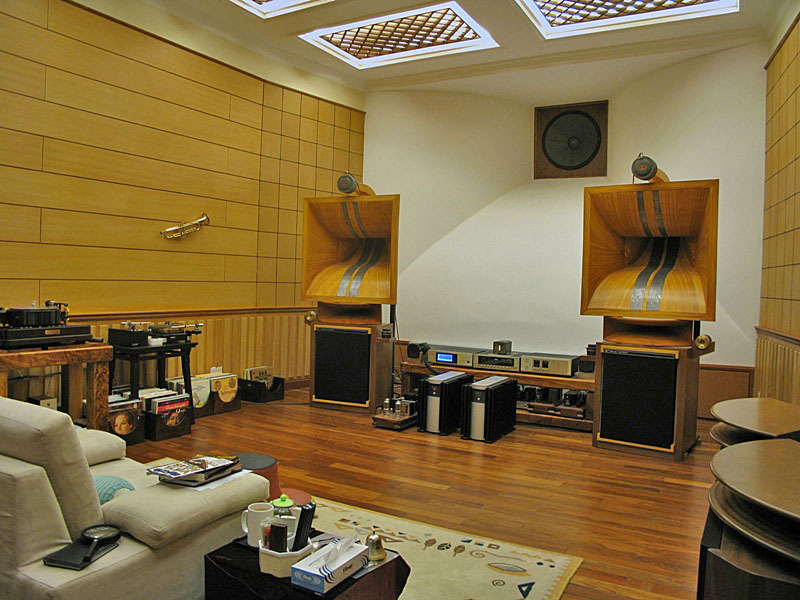I'm trying to figure out the best size for a full-range driver for my requirements. I don't need high treble because my hearing only goes to about 11K anyway, but I do like big bass. So, intuitively, it seems like a largish (8" or more) driver would be best. But I also am very interested in a good image and stage from a single driver and I wonder if smaller (4") drivers work best for that, since they come closer to pin-point. I just don't know if size is important (insert joke here) for that or not.
My ideal driver would be one that covers my frequency range with strong bass, a nice smooth, well developed mid and lower treble since that's what my ears listen for, good stage and image character, but as wide a listening sweet spot as possible (I also don't know the tradeoffs there). I have a pretty large room to fill, but I do have a favorite listening spot. I want to use it in an open baffle arrangement. So what are the tradeoffs between size, image, and listening width? Specific driver suggestions are welcome, of course. All I want is perfection, cheap. Is that too much to ask? Actually, my budget is modest, but I'm sure there is a best bang/buck compromise out there for this application.
I'm also strongly considering a woofer-augmented system, especially this one from MJK. Jordan JX92S OB with a Goldwood GW-1858 Woofer in an H Frame Project. I like this concept a lot, but I still wonder if I need the wide range of the Jordan and maybe could save some $ that way, but still get convincing mids up to about 10 Khz.
So, should I go with MJK's system as is (maybe a different, more affordable and more powerful full range because of room size) or would a larger, single driver work best?
My ideal driver would be one that covers my frequency range with strong bass, a nice smooth, well developed mid and lower treble since that's what my ears listen for, good stage and image character, but as wide a listening sweet spot as possible (I also don't know the tradeoffs there). I have a pretty large room to fill, but I do have a favorite listening spot. I want to use it in an open baffle arrangement. So what are the tradeoffs between size, image, and listening width? Specific driver suggestions are welcome, of course. All I want is perfection, cheap. Is that too much to ask? Actually, my budget is modest, but I'm sure there is a best bang/buck compromise out there for this application.
I'm also strongly considering a woofer-augmented system, especially this one from MJK. Jordan JX92S OB with a Goldwood GW-1858 Woofer in an H Frame Project. I like this concept a lot, but I still wonder if I need the wide range of the Jordan and maybe could save some $ that way, but still get convincing mids up to about 10 Khz.
So, should I go with MJK's system as is (maybe a different, more affordable and more powerful full range because of room size) or would a larger, single driver work best?
The bigger ,the slower . More cone area ,more mass . It is far better in having 2 X 3" speakers than a 5-6" single one . More velocity , transient attacks are reproduced better.
Also , for bass ,a 8" in dipole with active crossover would blend perfectly with a little satellite made with 2 X 2" .
Also , for bass ,a 8" in dipole with active crossover would blend perfectly with a little satellite made with 2 X 2" .
I'm trying to figure out the best size for a full-range driver for my requirements. I don't need high treble because my hearing only goes to about 11K anyway, but I do like big bass. So, intuitively, it seems like a largish (8" or more) driver would be best. But I also am very interested in a good image and stage from a single driver and I wonder if smaller (4") drivers work best for that, since they come closer to pin-point. I just don't know if size is important (insert joke here) for that or not.
My ideal driver would be one that covers my frequency range with strong bass, a nice smooth, well developed mid and lower treble since that's what my ears listen for, good stage and image character, but as wide a listening sweet spot as possible (I also don't know the tradeoffs there). I have a pretty large room to fill, but I do have a favorite listening spot. I want to use it in an open baffle arrangement. So what are the tradeoffs between size, image, and listening width? Specific driver suggestions are welcome, of course. All I want is perfection, cheap. Is that too much to ask? Actually, my budget is modest, but I'm sure there is a best bang/buck compromise out there for this application.
I'm also strongly considering a woofer-augmented system, especially this one from MJK. Jordan JX92S OB with a Goldwood GW-1858 Woofer in an H Frame Project. I like this concept a lot, but I still wonder if I need the wide range of the Jordan and maybe could save some $ that way, but still get convincing mids up to about 10 Khz.
So, should I go with MJK's system as is (maybe a different, more affordable and more powerful full range because of room size) or would a larger, single driver work best?
Everything is a trade off. Bigger drivers are more sensitive/efficient and better at delivering more bass. Smaller drivers are better in the midrange and have better high frequency dispersion. My preference seems to be with 4-5 inch drivers because they excel in the midrange but then again they won't play as loud which requires you to sit closer.
I see. So, let's take a typical 4" FR for example, like a Fostex or Jordan. Is it strong enough to handle a large room, such as 30' x 18'? I notice that most of these can only handle about 15-30 watts and I wonder if you need more size just to produce that much sound safely and smoothly. Or do you just parallel two speakers for that? Also, what affect does size have on image and stage?The bigger ,the slower . More cone area ,more mass . It is far better in having 2 X 3" speakers than a 5-6" single one . More velocity , transient attacks are reproduced better.
Also , for bass ,a 8" in dipole with active crossover would blend perfectly with a little satellite made with 2 X 2" .
As for bass, I always envisioned a 15" for me. I'm not sure that I need a fast response from the woofer so much, but I could be persuaded otherwise. I like to hear that big, smooth bass that you can feel through your body and feel air from it, but not necessarily the big punch. And I dread boomy bass. I haven't decided yet, but I do need to fill that big room.
My preference seems to be with 4-5 inch drivers because they excel in the midrange but then again they won't play as loud which requires you to sit closer.
That answers one question I had which was power handling. And mid range reproduction is important. Just how many 4" drivers would I need on an open baffle to handle a 30' x 18" room? My listening position is about 13' from speakers. I can adjust the speaker separation.
My experience is min. 8" for freedom of compression and max. 5" for clean highs. This 5" pro mid could have less compression than usual 5" fullrangers. Do you think the treble extension is enough for your old ears?
http://www.ciare.com/pdf/catalogo/PM135ND.PDF
hm confirmed with simulations that it should give bass in his double horns, despite the high fs.
hm-moreart
Haven't tried yet, but maybe I will (with a supertweeter)
http://www.ciare.com/pdf/catalogo/PM135ND.PDF
hm confirmed with simulations that it should give bass in his double horns, despite the high fs.
hm-moreart
Haven't tried yet, but maybe I will (with a supertweeter)
There are many factors -too many- that are involved in audio reproduction.
For a DIYer it is a matter of what you want ,what are your goals ,so you can tailor your system. As Sprinter said ,the room is big and the listening position is (relatively) far , so a system having costant directivity at all frequencies should be studied . A VLA (vertical line array) of many little drivers plus two or more subs ,not necessarily placed at floor level,would 'project' the sound very good . This is done with a very slim cabinet ,opposed to the big cabinets such as horns as suggested by German Forumers
As the listener is the target of the [missile ,bombs assault ]thing ...you (and I) should read and learn about the Directivity Index of a speaker system ,and the Polar Diagrams too..
For a DIYer it is a matter of what you want ,what are your goals ,so you can tailor your system. As Sprinter said ,the room is big and the listening position is (relatively) far , so a system having costant directivity at all frequencies should be studied . A VLA (vertical line array) of many little drivers plus two or more subs ,not necessarily placed at floor level,would 'project' the sound very good . This is done with a very slim cabinet ,opposed to the big cabinets such as horns as suggested by German Forumers
As the listener is the target of the [missile ,bombs assault ]thing ...you (and I) should read and learn about the Directivity Index of a speaker system ,and the Polar Diagrams too..
Last edited:
My preference seems to be with 4-5 inch drivers because they excel in the midrange but then again they won't play as loud which requires you to sit closer.
That answers one question I had which was power handling. And mid range reproduction is important. Just how many 4" drivers would I need on an open baffle to handle a 30' x 18" room? My listening position is about 13' from speakers. I can adjust the speaker separation.
It all depends on the sensitivity (in SPL) of the drivers and how much SPL you desire at your listening position.
Maximum power handling in watts is a thermal issue/limitation. How loud a driver can play depends on its listed sensitivity and excursion capability.
You can ask a lot of questions and get a lot of different answers, but ultimately you should do some listening and decide all this for yourself.
sprinter
hello,
if you like bass and a max. SPL ~95 db with the Jordan solo,
take a view to the TUBA,
more SPL ~106 dB take a look for the Trumpet or Schalmei for 8"
with Alphorn,
more SPL max.~ 110 dB why not the HORN sat with two ALPHORNS or a cornerhorn
thanks el´Ol, as he mentioned some double horns are also possible
hello,
if you like bass and a max. SPL ~95 db with the Jordan solo,
take a view to the TUBA,
more SPL ~106 dB take a look for the Trumpet or Schalmei for 8"
with Alphorn,
more SPL max.~ 110 dB why not the HORN sat with two ALPHORNS or a cornerhorn
thanks el´Ol, as he mentioned some double horns are also possible
Attachments
Last edited:
The bigger ,the slower . More cone area ,more mass . It is far better in having 2 X 3" speakers than a 5-6" single one . More velocity , transient attacks are reproduced better.
I'm afraid not. Mass affects efficiency, but it does not impact on transient response. Transient response is inherently linked to bandwidth covered & the acceleration of the powertrain is proportional only to the amount of current in the voicecoil. The equation B*L*i / Mms clearly demonstrates this, where B = magnetic strength in the Vc gap, L = length of the VC in the VC gap, i = current in the VC, and Mms = moving mass of the powertrain (all in SI units, naturally). Dan Wiggins's did a short writeup on the subject a few years ago: http://www.adireaudio.com/Files/WooferSpeed.pdf
Is it strong enough to handle a large room, such as 30' x 18'?
So much depends on how loud you have to have it.
My room is largish (bigger than yours). I think the sweet spot is 4-5". No matter the size of the FR, it will really need big helper woofer(s) to get real bass impact.
You can get pretty low (and with finesse) with some of the FRs in this size (the CSS EL70 is a real stunner in this department), but they just can;t move the air needed for lots of impact. Besides, freeing the FR of low bass, gives big imprvements in mirange & HF finese.
dave
Whoa  Scott !!
Scott !!
I wasn't clear -it should be noted that I'm quite a profane - I was referring more to the relation between cone diameter and directivity towards frequency .
As this implies also bandwidth and positioning of the speakers ...
...given the same motor , a lighter cone -and possibly little to reduce cone diaphgram non-linearities (break-ups)- has more speed ,thus being able to 'throw' sound to a longer distance .
I wasn't clear -it should be noted that I'm quite a profane - I was referring more to the relation between cone diameter and directivity towards frequency .
As this implies also bandwidth and positioning of the speakers ...

...given the same motor , a lighter cone -and possibly little to reduce cone diaphgram non-linearities (break-ups)- has more speed ,thus being able to 'throw' sound to a longer distance .
I'm afraid not. Mass affects efficiency, but it does not impact on transient response. Transient response is inherently linked to bandwidth covered & the acceleration of the powertrain is proportional only to the amount of current in the voicecoil. The equation B*L*i / Mms clearly demonstrates this, where B = magnetic strength in the Vc gap, L = length of the VC in the VC gap, i = current in the VC, and Mms = moving mass of the powertrain (all in SI units, naturally). Dan Wiggins's did a short writeup on the subject a few years ago: http://www.adireaudio.com/Files/WooferSpeed.pdf
Absolutely true, and let's not forget the inductance, Le, . Has a major impact on dynamics.
A good example, the TAD midrange 12" (!!) TM-1201 with Le= 0,68, BL=26,
mms = a whoppin' 60 grams, BUT the motor force is a brutal 14.500 G.
This driver is as "fast" and dynamic as it gets before moving to horns and CD's.
Rimshots etc. that will throw you out of your chair!
Concerning size of the optimal FR driver my absolute preferred would have to be 8". At least if your room has a fairly nice size, let's say 1.200 cu.ft. or more.
There is a reason for so many manufacturers offering this particular size of drivers, and YES, there are exeptions of course, but in general an 8" is quite capable and have compromises within reasonable values.
There is a reason for so many manufacturers offering this particular size of drivers, and YES, there are exeptions of course, but in general an 8" is quite capable and have compromises within reasonable values.
I can't believe those things can happily live in a single driver . It's just physics.I was referring more to the relation between cone diameter and directivity towards frequency
Phase shifts inherently happen when a speaker is requested to reproduce full band . Oh sorry
There is a reason for so many manufacturers offering this particular size of drivers
And i think too, some of that testoserone driven "mine is bigger than yours"
I've yet to hear a big driver (8") that doesn't give up midrange finese and downward dynamic range.
dave
In a room that big , I'd want 8" plus bass support, but then you lose dispersion. But you should have enough dispersion for a couch at 12' away.
An 8" starts losing highs around 2khz when seated off axis.
Playing with a tannoy arena loudspeaker (6.5" with ict tweet at center), I found 200hz worked well (24db/octave), 500hz was great for flattening volume, but 200hz was the best for keeping all the voice in the full range driver.
Dual 4", cone area near 120cm2 close to a 6" (listening to a single speaker with zero bass support) sounds congested 12' away at medium volume (listening to Blues Traveler). Now 4 x 4" (equal to an 8" cone area), that had enough area to satisfy me, but not keep me satisfied. Sitting arms length from the dual 4", there was bass. Move further away, there was no bass.
It all depends on dispersion you want, volume you listen at, music, and how far away you sit.
Norman
An 8" starts losing highs around 2khz when seated off axis.
Playing with a tannoy arena loudspeaker (6.5" with ict tweet at center), I found 200hz worked well (24db/octave), 500hz was great for flattening volume, but 200hz was the best for keeping all the voice in the full range driver.
Dual 4", cone area near 120cm2 close to a 6" (listening to a single speaker with zero bass support) sounds congested 12' away at medium volume (listening to Blues Traveler). Now 4 x 4" (equal to an 8" cone area), that had enough area to satisfy me, but not keep me satisfied. Sitting arms length from the dual 4", there was bass. Move further away, there was no bass.
It all depends on dispersion you want, volume you listen at, music, and how far away you sit.
Norman
- Status
- This old topic is closed. If you want to reopen this topic, contact a moderator using the "Report Post" button.
- Home
- Loudspeakers
- Full Range
- Best size for full-range driver?



